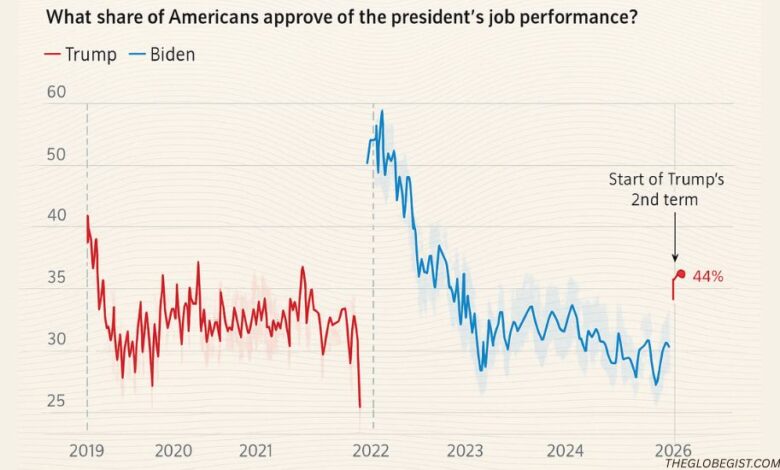Trump Approval Rating: A Comprehensive Analysis of Shifting Public Opinion

The Trump approval rating has long been a focal point in American politics, not just as a measure of support for Donald Trump’s presidency but also as a reflection of the deep divisions in U.S. society. From his first term to his return to the White House, Trump’s approval rating has consistently hovered in a narrow range, with peaks and troughs often tied to major policy decisions, controversies, or global events.
This article provides a detailed analysis of Trump’s approval rating, drawing from Gallup, Pew Research, AP-NORC, Quinnipiac, and independent polling averages. It examines demographic splits, regional differences, issue-based ratings, and what these numbers mean for Trump’s political future.
The Current State of Trump’s Approval Rating
As of late summer 2025, Trump’s approval rating remains polarized. Gallup’s August data placed his overall approval at 40%, with a strong partisan divide: 93% of Republicans approve, compared to just 1% of Democrats. Pew Research placed his approval slightly lower at 38%, with 60% disapproving.
These figures demonstrate a persistent reality: Trump’s ratings rarely break out of the 37–44% range. While this stability is unusual compared to past presidents, it also highlights how entrenched opinions about Trump have become.
Trump’s Approval Rating on Key Issues
Polls show that Americans differentiate between Trump’s overall leadership and his performance on specific issues.
-
Economy: Once Trump’s strongest area, approval has slipped to around 37%, down from averages above 50% during his first term. Rising costs and tariff impacts appear to be factors.
-
Education: Only 38% approve of his handling of education, reflecting public debates about federal involvement in curriculum and student debt policies.
-
Foreign Policy: Gallup found his highest marks on Iran (42%) and foreign affairs in general (41%). However, his approach to Ukraine remains weak, with only 33% approval.
-
Immigration: A June CNN poll showed Trump underwater, dropping to –2% net approval after controversial enforcement measures.
These issue-based numbers reveal that while Trump still commands loyalty among Republicans, his policies often generate more opposition than support among independents and Democrats.
The Role of Independents
Perhaps the most significant trend shaping Trump’s approval rating is the opinion of independents. In July 2025, Gallup reported that only 29% of independents approved of Trump’s performance—the lowest of his second term.
Independents are often seen as the swing bloc in U.S. elections. Their disapproval, particularly on policies like immigration and fiscal management, suggests challenges for Trump in both approval ratings and electoral outcomes.
Regional Variations
Approval ratings are not uniform across the country. Polls in swing states show sharper declines than national averages:
-
North Carolina: Trump’s net approval is –9 points, signaling potential trouble in a key battleground.
-
Midwestern States: Industrial tariff policies have generated mixed reactions, with many voters skeptical of their long-term benefits.
-
Southern States: Strong Republican loyalty keeps approval ratings higher, though not immune to national trends.
Regional divides underscore why national averages only tell part of the story. Local economies, cultural attitudes, and media landscapes shape how Trump’s presidency is viewed.
Age and Demographic Trends
Demographic analysis shows interesting variations in Trump’s approval rating:
-
Older Voters (65+): Newsweek reported a rebound among baby boomers, with approval rising from 38% to 40% between June and August 2025. Support on the Russia–Ukraine issue increased from 37% to 45% in this age group.
-
Younger Voters (18–34): Approval remains very low, often in the 20–25% range, reflecting strong liberal leanings and disapproval of Trump’s social policies.
-
Racial/Ethnic Groups: Approval among white voters remains stronger than among Black and Hispanic voters, where ratings often fall below 20%.
These splits show that Trump’s coalition is heavily reliant on older, white, and Republican-identifying voters, while other groups remain largely opposed.
Comparing Approval to Disapproval
Trump’s disapproval rating has consistently been higher than his approval. For example:
-
Nate Silver’s polling average (Sept. 2025) shows 44.1% approve vs. 51.7% disapprove, for a net –7.6 points.
-
Pew Research recorded 38% approval vs. 60% disapproval.
-
Quinnipiac polls found only 37% approve, while 56% opposed his decision to deploy the National Guard in D.C.
These numbers reveal not only steady opposition but also the narrow ceiling of support that Trump faces.
How Trump Responds to Polling
Despite consistently modest ratings, Trump often disputes polling data. Recently, he claimed his approval was “in the 60s and 70s,” dismissing Gallup and Reuters/Ipsos results as inaccurate. However, independent surveys consistently place him in the low 40s.
This disconnect highlights how Trump leverages narrative control. For his base, poll numbers matter less than his ability to project strength and resilience against what he portrays as a biased media environment.
Why Trump’s Approval Rating Matters
Approval ratings serve several functions in political analysis:
-
Electoral Predictors: Historically, presidents with approval below 45% face difficulties in re-election or maintaining party control of Congress.
-
Policy Legitimacy: Low approval can undermine the public’s confidence in major legislative efforts. Trump’s “One Big Beautiful Bill,” for example, is supported by only 26% of independents.
-
Media Framing: Approval ratings are often used as shorthand for presidential success or failure, shaping how both supporters and critics frame the administration.
In Trump’s case, his relatively stable but low ratings demonstrate both the loyalty of his base and the challenges of expanding beyond it.
Historical Context
Compared to other presidents:
-
Trump’s approval rating is unusually stable, rarely exceeding 45% but rarely dipping below 35%.
-
Past presidents such as George W. Bush and Barack Obama experienced wider fluctuations tied to crises or major achievements.
-
This stability reflects not moderation, but rather polarization. Voters are deeply entrenched in their views of Trump, and events rarely shift opinions significantly.
The Future of Trump’s Approval Rating
Looking ahead, several factors will shape Trump’s approval rating:
-
Economic Performance: Rising tariffs and questions about federal spending will continue to influence public perception.
-
Foreign Policy Crises: Decisions on Ukraine, Russia, and Iran may cause short-term bumps or declines.
-
Upcoming Elections: Approval ratings in key states like North Carolina and Pennsylvania may foreshadow electoral outcomes.
-
Independent Voters: Their disapproval trend could be the defining factor of Trump’s legacy.
Conclusion
The Trump approval rating is more than a number—it’s a barometer of how Americans perceive one of the most polarizing figures in modern political history. Despite unwavering support from Republicans, independents and Democrats keep his ratings below 45%. Issue-specific polls show persistent weaknesses on the economy, immigration, and government spending, while older demographics provide some pockets of resilience.
As Trump’s presidency continues, approval ratings will remain a critical measure of his political strength, his ability to push policy, and his viability in future elections. For readers seeking ongoing insights into political trends, The Globe Gist will continue providing in-depth analysis of stories like this one.
1. What is Donald Trump’s current approval rating?
As of September 2025, Trump’s approval rating ranges between 37% and 44%, depending on the polling source.
2. Which polls are most reliable for Trump’s approval rating?
Gallup, Pew Research Center, AP-NORC, Quinnipiac, and Nate Silver’s polling averages are considered among the most reliable.
3. Has Trump’s approval rating ever gone above 50%?
Yes, briefly during his first term in 2020 around the early COVID-19 response, but in his second term ratings have mostly stayed below 45%.
4. Why is Trump’s approval rating so stable compared to past presidents?
His rating remains stable because of deep political polarization—supporters are loyal while critics remain firmly opposed.
5. How do Republicans view Trump’s performance?
About 93% of Republicans approve of Trump’s performance, showing near-universal loyalty within his party.
6. What percentage of Democrats approve of Trump?
Very few—polls show only about 1% of Democrats currently approve of Trump’s leadership.
7. How do independents view Trump’s presidency?
Independents are much less supportive, with only 29–35% approval depending on the poll, representing one of his weakest voter segments.
8. What issues hurt Trump’s approval rating the most?
Key issues include immigration enforcement, tariff policies, and federal spending, where approval ratings often fall below 40%.
9. What issues boost Trump’s approval rating?
Foreign policy areas like Iran and his tough stance on Russia occasionally push his approval into the low 40s.
10. What is Trump’s approval rating on the economy?
Currently around 37%, a sharp drop from his first-term averages above 50%.
11. What is Trump’s approval rating on immigration?
Recent CNN data showed his immigration approval sinking to a –2% net rating, among his lowest marks.
12. Do older voters support Trump more than younger voters?
Yes. Voters aged 65+ give him around 40% approval, while younger voters (18–34) often show approval in the low 20s.
13. How does Trump’s approval rating compare to Joe Biden’s?
Biden’s approval rating also struggles in the low 40s, but Trump’s tends to be slightly more stable due to stronger partisan loyalty.
14. What is Trump’s approval rating in swing states?
In states like North Carolina, Trump’s net approval is –9 points, signaling challenges in battleground regions.
15. How does race affect Trump’s approval rating?
Approval is higher among white voters compared to Black and Hispanic voters, where ratings often remain under 20%.
16. Has Trump’s approval rating improved in 2025?
It has fluctuated slightly but remains largely stable; some small gains have been seen among older voters.
17. How do Americans view Trump’s handling of education?
Around 38% approve of his handling of education policies, reflecting skepticism over federal involvement.
18. Does Trump’s approval rating affect upcoming elections?
Yes, approval ratings below 45% are historically linked to difficulties in re-election and congressional midterms.
19. How does Trump respond to low approval ratings?
Trump often disputes polling numbers, claiming his support is much higher, especially among his core base.
20. Why does Trump’s approval rating matter?
It serves as a measure of his political strength, his ability to push policy, and his chances of maintaining influence in U.S. politics.
Thanks for read our article if you want more like this kind of article visit our site The Globe Gist, and comment us. We provide authentic & comprehensivf information to our readers.



